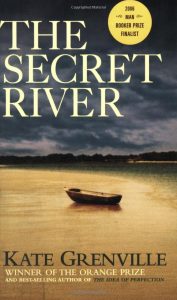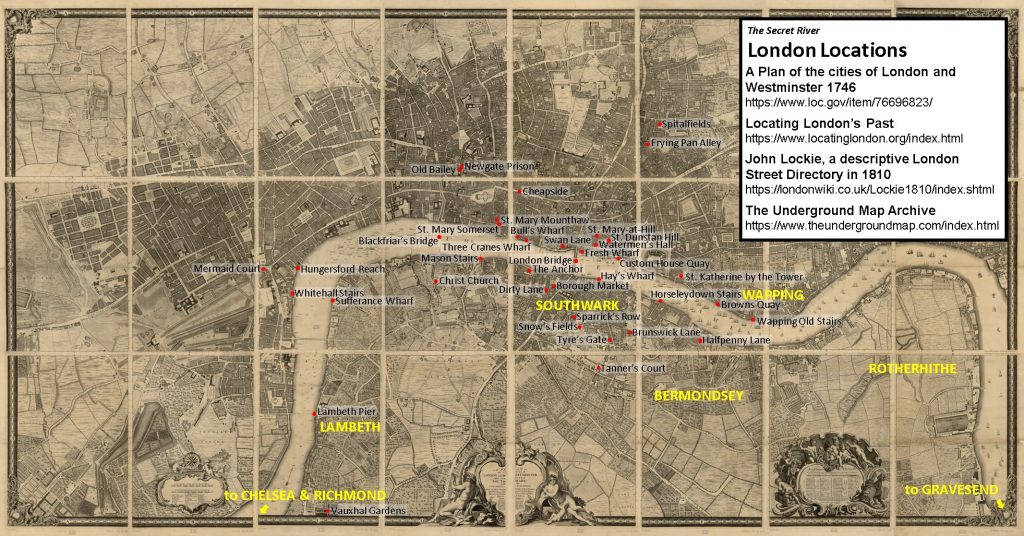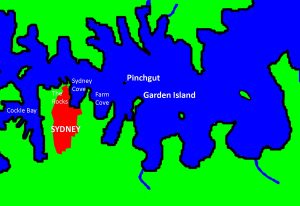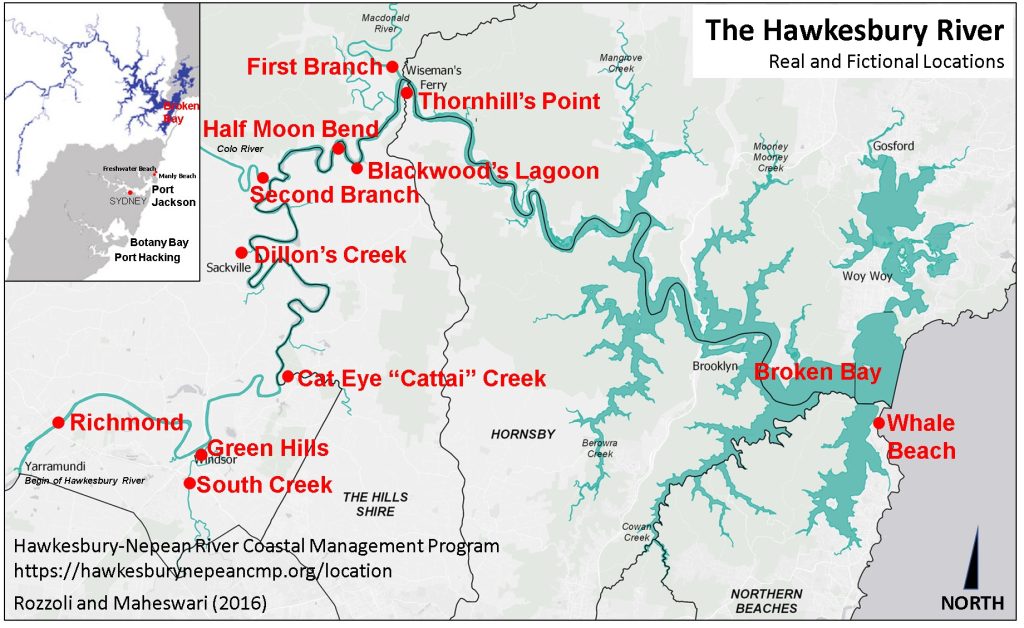Required Course Reading
 From the Backcover: “In 1806 William Thornhill, an illiterate English bargeman and a man of quick temper but deep compassion, steals a load of wood and, as a part of his lenient sentence, is deported, along with his beloved wife, Sal, to the New South Wales colony in what would become Australia. The Secret River is the tale of William and Sal’s deep love for their small, exotic corner of the new world, and William’s gradual realization that if he wants to make a home for his family, he must forcibly take the land from the people who came before him.”
From the Backcover: “In 1806 William Thornhill, an illiterate English bargeman and a man of quick temper but deep compassion, steals a load of wood and, as a part of his lenient sentence, is deported, along with his beloved wife, Sal, to the New South Wales colony in what would become Australia. The Secret River is the tale of William and Sal’s deep love for their small, exotic corner of the new world, and William’s gradual realization that if he wants to make a home for his family, he must forcibly take the land from the people who came before him.”
Combining historical figures, locations, and events, Grenville’s novel is an honest and historically accurate portrayal of how the European invaders and the Aboriginal People experienced the early colonial period of Australia. Those early experiences of suffering, violence, and oppression, as well as courage, persistence, and tenacity continue to shape and influence Australian identity, politics, and society today.
An accurate understanding of the modern Australian ecosystem and efforts to conserve it, can only be achieved through the lens of Australian history and prehistory, especially the experience of Aboriginal Peoples. Grenville’s book provides a wonderful foundation and starting point for our discussions of the environmental impacts of colonization, the role of Aboriginal People’s stewardship of land and biodiversity, and modern efforts to protect and preserve the unique Australian ecosystem.
The Secret River was also turned into a TV Mini-Series by ABC Australia.
The Secret River Resources
Here you will find additional resources that enrich your reading of Grenville’s historical novel. All of these resources are optional and, hopefully, will greatly aid your comprehension of the historical and cultural framework of the novel.
Part ONE London (66 pages).– Click on the map (or download) to view London locations mentioned in the book. This map is from 1746. Remember that William Thornhill was born ca. 1777, so add ~30 years of development to the map in your head. For example, Blackfriars Bridge was not completed until 1769, and many of the districts that had been rural in the 1740s, were urban by Thornhill’s days.
Reaches – segments of the Thames River between landmarks
Steps or Stairs – access points to the river for foot traffic to access small boats
Banks – segments of shoreline along the Thames River
Pier – a narrow platform extending into the river where ships could moor
Quay – a level platform, usually parallel along the bank, where ships could moor
Wharf – a quay for the unloading and loading of ships.
Click on the following locations to learn more about them: Bermondsey, Billingsgate, Blackfriars Bridge, Borough Market, Bull Wharf, Cheapside, Chelsea, Christ Church, Cobham Hall, Customs House Quay, Fresh Wharf, Gravesend, Hay’s Wharf, Horseleydown Stairs, Lambeth, Lambeth Pier, London Bridge, Mason’s Stairs, Newgate Prison, Old Bailey, Richmond, Rotherhithe, Saint Mary Mounthaw, Snow’s Field , Southwark, Spitalfields, St. Dunstan’s Hill, St. Katherine-by-the-Tower, St. Mary-at-Hill, St. Mary Somerset, Sufferance Dock, Tanner’s Court or Yard, The Anchor, Three Cranes Wharf, Vauxhaul Gardens, Wapping, Wapping Old Stairs, Waterman, Waterman’s Hall, Whitehall Stairs
People, Concepts, Items: Alexander , Brazil Wood, Captain Suckling (perhaps inspired by), Doggett’s Coat and Badge, Frost Fair, Lascar, Lord Hawkesbury, Nettlefold and Mosers (perhaps inspired by).
Places that could not be unequivocally identified or geo-located: Acre Wharf, Ash Court, Cash’s Ground, Cornish Stairs, Crawshay’s Warf, Friend in Hand, Gosport Street, Red Lion Quay, Sloan’s Dock
————————————————————————–
 Part TWO Sydney (52 pages).– The second part of the book plays in the Sydney colony and its surrounding area. Click on the map on the left for a regional overview, the map on the right for the Sydney area, and HERE for a map of the 1807 Sydney Colony as William and Sal would have encountered it. The map at bottom shows both the fictional and real Hawkesbury River Locations.
Part TWO Sydney (52 pages).– The second part of the book plays in the Sydney colony and its surrounding area. Click on the map on the left for a regional overview, the map on the right for the Sydney area, and HERE for a map of the 1807 Sydney Colony as William and Sal would have encountered it. The map at bottom shows both the fictional and real Hawkesbury River Locations.
Click on the following Sydney and Region locations to learn more about them:Church Street (today’s northernmost block of York Street), Cockle Bay, Garden Island, The Heads, The Rocks, South Head, South Head Lighthouse, Sydney Cove, Pinchgut Island, Port Jackson
 Click on the following events and terms to learn more about them: Customs Wharf, Government Stores, Jupiter (ship), King George III, Legitimate (Free Settler), Lime, Mangroves, Oyster Shell Middens, Pannikin, Rose Hill Packet, Smallpox, Sydney Gazette, The Governor (Lachlan Macquarie), Ticket of Leave, Van Diemen’s Land, Wattle , Wherry
Click on the following events and terms to learn more about them: Customs Wharf, Government Stores, Jupiter (ship), King George III, Legitimate (Free Settler), Lime, Mangroves, Oyster Shell Middens, Pannikin, Rose Hill Packet, Smallpox, Sydney Gazette, The Governor (Lachlan Macquarie), Ticket of Leave, Van Diemen’s Land, Wattle , Wherry
The original street grid of the colony is still preserved in the layout of the Sydney Central Business District Today, see HERE.
Click on the following locations on the Hawkesbury River to learn more: Broken Bay, First Branch (MacDonald River), Green Hills, Thornhill’s Point (Wisemans Ferry)
Thornhill’s Point is based on Wiseman’s Ferry. Blackwood Lagoon is a fictional name, but the location “5 miles up from the First Branch” puts this at today’s Leetsvale Caravan Park. Although there is a small “lagoon” at the park, this is an artificial feature dug out in the late 20th century.
————————————————————————
Part THREE – A Clearing in the Forest (62 pages).–The third part of the book shifts the focus of events to the Hawkesbury River. For locations see map above.
Click on the following locations to learn more about them: Manly, Freshwater, Whale Point, South Creek, The Cowpastures, Dillon’s Creek (Lilburndale), Half Moon Bend, Cat Eye Creek (Cattai Creek), The Crown and The Blue Boar (not real but probably inspired by here and here), Second Branch (Colo River)
Click on the following terms to learn more about them: Damper, Southern Cross, Johnny-Cakes, Commissioner of Convicts, Milk fever, Guineas, Emancipist
————————————————————————
Part FOUR – A Hundred Acres (48 pages).– The fourth part of the book has Sal and William settle into their new homestead and make first contact with the local Aboriginal Peoples.
Click on the following locations to learn more about them: Windsor (see Green Hills), Richmond
Click on the following terms to learn more about them: calico, humpy, river oaks, brass farthing, stringybark, paperbark, white ants, cabbage tree
Places that could not be unequivocally identified or geo-located: Sandy Island
————————————————————————
PART FIVE – Drawing a Line (38 pages).– The fifth part of the book sees the settler’s world collide with that of the Aboriginal Peoples.
Click on the following terms and people to learn more about them: Tricorn
Click on the following locations to learn more about them: Cherry Gardens, Swan Wharf, Mullet Island (Danger Island), Shrewsbury, Wilberforce
People or places that could not be identified: Captain MacCullum, Saint Mary Magdalene Church, Hatter’s Lane, Butler’s Building, Darkey Creek
————————————————————————
PART SIX – The Secret River (38 pages) & Mr. Thornhill’s Villa (23 pages). — The dark and violent conclusion of the Hawkesbury settlement story.
Click on the following locations to learn more about them: Bermondsey, Covent Garden, White’s Grounds, Crucifix Lane, Swan Lane, Maid of the River (probably a melding of Wiseman’s Ferry Inn and the Maid of Australia Inn), Sackville, Wheelbarrow Flat (perhaps inspired by Wheelbarrow Ridge), Portland Head, Freeman’s Reach, Milkmaid Reach
Click on the following terms and people to learn more about them: the Cross, the Pointers, the Frying Pan
————————————————————————
Find out what happens to the Thornhills in Kate Grenville’s follow-up novel “Sarah Thornhill“. For more stories, inspiration, and history behind The Secret River, check out Kate Grenville’s Searching for the Secret River.
For more historical fiction of Australian colonial history by Kate Grenville, see “The Lieutenant“, and “A Room Made of Leaves“

